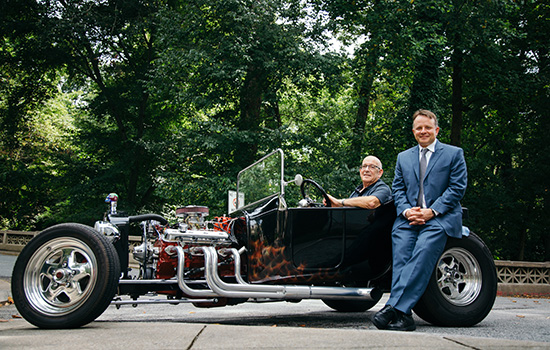Catching Cancer Early
By Dana Goldman, Photography By Stephen Nowland

When Field Willingham gave patient Robert May the good news this year that the retiree would need only once-yearly appointments going forward, May was, in his own words, "a little disappointed." They had first met in 2014, when Willingham, a Winship expert in gastrointestinal malignancies and director of Endoscopy in Emory's Division of Digestive Diseases, treated May for an early-stage esophageal cancer and for Barrett's esophagus, a disease that damages cells lining the esophagus and can sometimes progress to esophageal cancer. For May, whose first wife died of cancer, his initial treatment at Winship and biannual check-ups with Willingham were reassuring. "I liked seeing him twice a year," says May. "It was nice to know I was under his care."
May was lucky he was diagnosed early and treated at Winship. Previously, physicians were trained to treat Barrett's esophagus and other cancer precursors with major surgery. But thanks to developments in technology, his cancer was successfully cured with a minimally invasive endoscopic procedure. Endoscopy uses a long, narrow tube inserted down the throat to peer into the gastrointestinal tract and treat conditions before they turn cancerous. Recent studies by Willingham and others show that more than 90 percent of patients with early esophageal cancers can be cured with the new endoscopic approaches.
Willingham was able to perform several advanced endoscopic procedures to remove and then destroy the early-stage cancer and pre-cancerous growths in May's esophagus without surgery: endoscopic mucosal resection (EMR) removed the small cancer there, and radiofrequency ablation used heat energy to destroy pre-cancerous tissue. Subsequent endoscopic procedures ensured that the condition was gone for good. Now, four years after his initial diagnosis, 71-year-old May is cancer free and Willingham says the risk of future esophageal cancer has dropped dramatically for his patient. There is no need for biannual appointments to confirm May's good health.

Robert May built this 1923 model T roadster during treatment. This summer, he drove it to Emory where his doctor, Field Willingham, got to see the car he had heard so much about.
Advances in endoscopy couldn't have come at a better time. The incidence of esophageal cancer has been on the rise, an increase that Willingham and others believe relates to lifestyle changes over the last decades. "As we're getting more and more obese as a nation, it may be driving up our rates of reflux and consequentially our rates of esophageal cancer," says Willingham.

Jennifer Christie, clinical director of Gastroenterology at the Emory Clinic. |
His colleague Jennifer Christie says that colorectal cancers have also been increasing in frequency in younger adults, likely also related to lifestyle factors or unknown biological factors. "Some of the incidents are related to things that we can modify, factors such as diet, the use of alcohol, and smoking," says Christie, who is the clinical director of Gastroenterology at the Emory Clinic and has performed thousands of colonoscopies, a type of endoscopy. Younger people and African Americans are among the populations with the largest increases in colorectal cancers; in response, a few years ago the U.S. Multi-Society Task Force on Colon Cancer began recommending that African Americans be screened for colorectal cancer at age 45 instead of age 50. This year, the American Cancer Society issued a new recommendation that all people, regardless of race, begin screenings at age 45.
While esophageal and colorectal cancers in younger individuals have been on the rise, Christie says that proactive screening measures are helping. "The death rate has been falling because we've expanded screening," says Christie. "We're removing polyps early so they don’t have the opportunity to develop into cancers. We are also catching cancers earlier." At the same time, she knows physician-researchers need to continue to pinpoint who is most at risk—and why. After all, the new screening guidelines could increase demand for colonoscopy before there are enough resources in place to meet the demand. "We need more information about whether there is a sub-population we need to further target," she says. "We really need to understand who are those younger folks who are at higher risk and how can we educate them about the lifestyles or even genetic factors that put them at higher risk."
In the meantime, Winship and Emory gastroenterology teams work together to give patients the most advanced treatment options. Emory gastroenterologist Qiang Cai is one of the first doctors in the Southeast to do endoscopic submusocal dissection (ESD), which uses endoscopy tubes to remove early-stage gastrointestinal tumors. Unlike older treatments for these cancers, ESD is minimally-invasive and allows Cai to eliminate tumors without major surgery and without negatively impacting major bodily organs.
May is relieved that Willingham was able to cure his cancer and spare him a more invasive procedure. If not for endoscopy, he likely would have needed an esophagectomy, a major surgery to remove a section of his esophagus. "I was told it was a risky operation with a risky recovery," says May. "The idea of having a section of my esophagus taken out and stitched back together was kind of scary."
Instead, May says that the endoscopy procedures have been as straightforward as promised. "It's been a very simple process," says May. "I've had absolutely no complications whatsoever, not even a sore throat."
Willingham isn't surprised. "Most patients do extremely well with the procedure, which is, by nature, minimally invasive."
Since he's cancer free, May spends his days building cabinets, tending his garden, meeting friends for lunch, and going for leisurely drives with his wife. After his successful procedure in 2014, he began building the car he'd been dreaming of for decades: a 1923 model T roadster. Over 16 months, he handled everything from the electrical to the mechanical aspects to the assembly of the car.
Now he enjoys not just his good health but also his labor of love. "The car runs beautifully," says May. "I'm really enjoying my retirement. I'm a very lucky guy."
